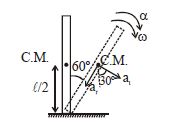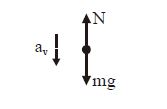Q.
A thin and uniform rod of mass M and length L is held vertical on a floor with large friction. The rod is released from rest so that it falls by rotating about its contact-point with the floor without slipping. Which of the following statement(s) is/are correct, when the rod makes an angle 60$^{\circ}$ with vertical ?
[g is the acceleration due to gravity]
Solution:
We can treat contact point as hinged.
Applying work energy theorem
$W_{g} = \Delta KE.$
$mg \frac{\ell}{4} = \frac{1}{2}\left(\frac{m\ell^{2}}{3}\right)\omega^{2}$
$\omega = \sqrt{\frac{3g}{2\ell}}$
radial acceleration of C.M. of rod $= \left(\frac{\ell}{2}\right)\omega^{2} = \frac{3g}{4}$
Using $\tau = I \alpha$ about contact point
$\frac{mg\ell}{2}sin\,60^{\circ} = \frac{m\ell^{2}}{3}\alpha$
$\Rightarrow \,\alpha = \frac{3\sqrt{3}}{4\ell}g$
Net vertical acceleration of C.M. of rod
$a_{v} = a_{r} \,cos\,60^{\circ} + a_{t} \,cos\,30^{\circ}$
$= \left(\frac{3g}{4}\right) \left(\frac{1}{2}\right) + \left(\alpha \frac{\ell}{2}\right)cos\,30^{\circ}$
$= \frac{3g}{8}+\frac{3\sqrt{3g}}{4\ell}\left(\frac{\ell}{2}\right)\left(\frac{\sqrt{3}}{2}\right)$
$= \frac{3g}{g}+\frac{9g}{16} = \frac{15}{16}g$
Applying $F_{net}$ = ma in vertical direction on rod as system
$mg - N = ma_{v} = m \left(\frac{15}{16}g\right)$
$\Rightarrow \,N = \frac{mg}{16}$

